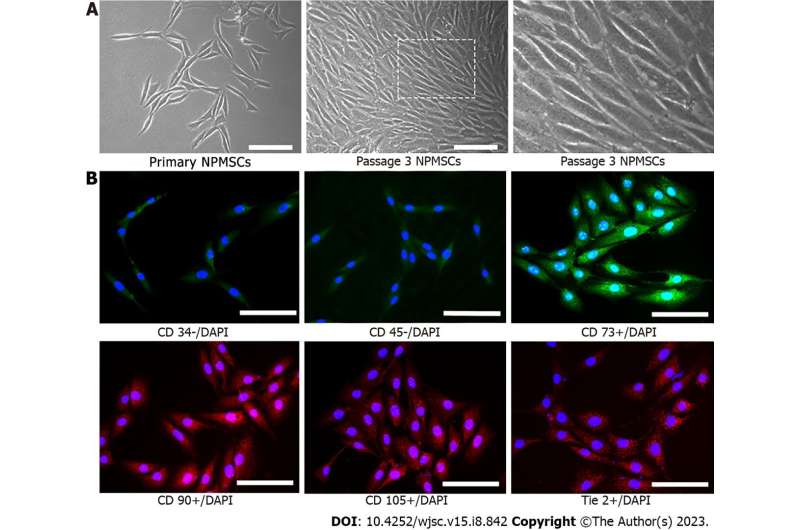This article has been reviewed according to Science X's editorial process and policies. Editors have highlighted the following attributes while ensuring the content's credibility:
fact-checked
proofread
Quercetin ameliorates oxidative stress-induced senescence in rat nucleus pulposus-derived mesenchymal stem cells: Study

Intervertebral disk degeneration (IDD) is a main contributor to low back pain. Oxidative stress, which is highly associated with the progression of IDD, increases senescence of nucleus pulposus-derived mesenchymal stem cells (NPMSCs) and weakens the differentiation ability of NPMSCs in degenerated intervertebral disks (IVDs). Quercetin (Que) has been demonstrated to reduce oxidative stress in diverse degenerative diseases.
For the study published in World Journal of Stem Cells, NPMSCs were isolated from rat tails in vitro. Senescence-associated β-galactosidase (SA-β-Gal) staining, cell cycle, reactive oxygen species (ROS), real-time quantitative polymerase chain reaction (RT-qPCR), immunofluorescence, and western blot analyses were used to evaluated the protective effects of Que. In addition, the relationship between miR-34a-5p and Sirtuins 1 (SIRT1) was evaluated by dual-luciferase reporter assay.
To explore whether Que modulates tert-butyl hydroperoxide (TBHP)-induced senescence of NPMSCs via the miR-34a-5p/SIRT1 pathway, the researchers used adenovirus vectors to overexpress and downregulate the expression of miR-34a-5p and used SIRT1 siRNA to knockdown SIRT1 expression. In vivo, a puncture-induced rat IDD model was constructed, and X rays and histological analysis were used to assess whether Que could alleviate IDD in vivo.
The team found that TBHP can cause NPMSCs senescence changes, such as reduced cell proliferation ability, increased SA-β-Gal activity, cell cycle arrest, the accumulation of ROS, and increased expression of senescence-related proteins, while the abovementioned senescence indicators were significantly alleviated by Que treatment.
Que decreased the expression levels of senescence-related proteins (p16, p21, and p53) and senescence-associated secreted phenotype (SASP), including IL-1β, IL-6, and MMP-13, and it increased the expression of SIRT1. In addition, the protective effects of Que on cell senescence were partially reversed by miR-34a-5p overexpression and SIRT1 knockdown. In vivo, X-ray, and histological analyses indicated that Que alleviated IDD in a puncture-induced rat model.
In summary, the present study provides evidence that Que reduces oxidative stress-induced senescence of NPMSCs via the miR-34a/SIRT1 signaling pathway, suggesting that Que may be a potential agent for the treatment of IDD.
More information: Wen-Jie Zhao et al, Quercetin ameliorates oxidative stress-induced senescence in rat nucleus pulposus-derived mesenchymal stem cells via the miR-34a-5p/SIRT1 axis, World Journal of Stem Cells (2023). DOI: 10.4252/wjsc.v15.i8.842
Provided by World Journal of Stem Cells





















